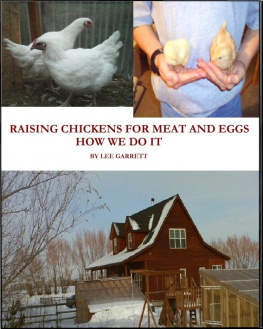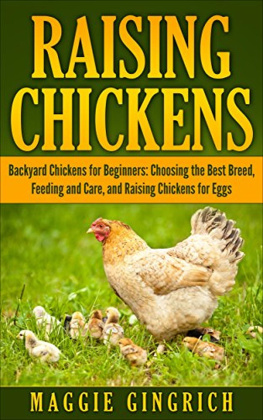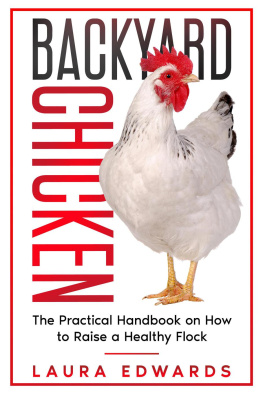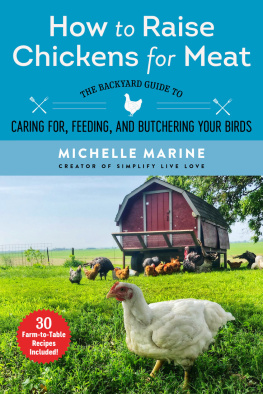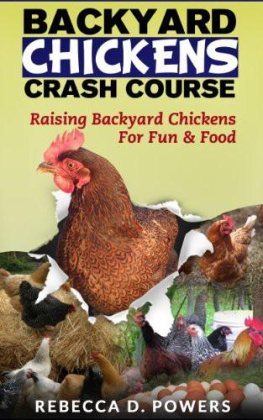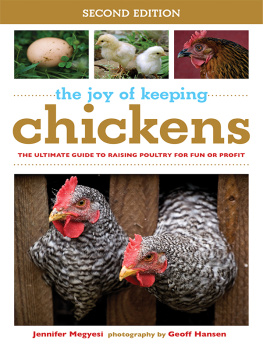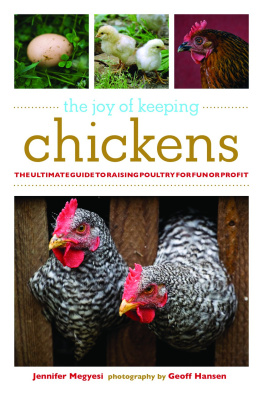Copyright:
Raising Chickens For Meat and Eggs: How We DoIt
Lee Garrett
Copyright 2014 by LeeGarrett
SmashwordsEdition
Smashwords License Statement
This e-book islicensed for your personal enjoyment only. This e-book may not bere-sold or given away to other people. If you would like to sharethis book with another person, please purchase an additional copyfor each reader. If youre reading this book and did not purchaseit, or it was not purchased for your use only, then please returnto your favorite retailer and purchase your own copy. Thank you forrespecting the hard work of this author. Copyright 2014 E.L. Garrett. All rights reserved worldwide.
Introduction:
In this worldof continuously escalating food prices, and ever-increasingknowledge of the poor quality of commercially grown food, ourfamily has tried to become a little more self-sufficient. We havelearned through trial and error how to significantly increase oursuccess, with the chickens that we raise for food. The recenteconomic downturn and a renewed interest in locally grown, organicfoods havecontributed to the new interest in raising chickens for eggs andmeat. Raising chickens organically simply means to raise themwithout synthetic chemicals, and only with chemical free foodsources. Our chickens are fed medicated feed for the first theeweeks of life. Then the food that they eat is completely free ofhormones or any other non-organic substance. Free-range chickensthat are let out of their enclosures, get direct sunlight and freshair, and are much healthier than those that are caged throughouttheir lives. Our free-ranging chickens through their freedom ofmovement eat insects, seeds, and plant roughage, which contributeto their good health, and the healthy products that they producefor us. This is how we raise our chickens.
Laying Chickens:
Laying chickens are probablythe easiest of animals to take care of, after making predator proofhousing for them to live in. Our day-to-day routine involves makingsure that they have enough food and water, and collecting theireggs. Laying chickens can be purchased by ordering them through themail, or buying them at a local farm supply store around late Aprilor early May. When ordering through the mail we call a supplier andorder what kind and how many chicks we want, over the phone. Thisusually involves paying by credit card over the phone at the sametime. Then the chicks are shipped to the nearest post office wherewe will pick them up. The new chicks are shipped in a cardboard boxand will need to be picked up on the same day that the post officecalls. So far the new chicks have always arrived alive and health,although we usually lose a chick or two in the first couple of daysafter their arrival, probably from the stress of shipping. Buyingour chicks from a local farm supply store just involves calling thestore in the spring, late February to early March, to find out whenthey will get some chicks shipped to the store. Then driving intotown to pick out what we want. The store will supply a littlecardboard carrier that the chicks will come home in. The varieties,which we like, are Barred Plymouth Rock, Leghorns, and Red Sexlinks, which are prescreened to be hens. They are all good layersand have a good feed to egg production rate. In other words theyuse a high proportion of the feed efficiently, to produce eggs.Some breeds have to eat more feed to produce eggs, which makes themless efficient and cost effective. When the chicks are purchasedthey are a day or two old and need a heat lamp to keep them warm.We keep them in a cardboard box with newspaper in the bottom, and a100-watt lamp suspended above them, clamped to a wooden two-inch bytwo-inch board. A cheap work-light type of lamp with a bell shapedreflector and a clip to hold it in place works best, so it can stayin place above the chicks. The distance of the light above thechicks should be determined by trial and error, because there areseveral factors, which determine this. Factors such as the size ofthe box they are in, and the surrounding air temperature willaffect the height that the lamp should be placed. If the lamp isset at a certain height and the chicks huddle together right underit, then it is set too high and they are cold. If the chicks wontstay under the light but stay around the perimeter of the lit area,then the light is too low and they are hot. We use newspaper in thebottom of their box, which should be changed daily. And, theyshould always have food and water. We give the new chicks amedicated chick starter feed at first, until they are about threeor four weeks old. At first we started with two chickens and now wekeep about 12 and as many as 25. Sometimes a friend will get tiredof their chickens and want us to take them off of their hands. So,at times we can end up with quite a few chickens. The chickens willbegin to lay eggs after they are about 18 to 22 weeks old, and keepproducing up to around three years of age. As they get closer tothe three years of producing eggs they produce less and less, andhave to be retired when they stop all together. Otherwise, theywill keep eating the feed but not give back any eggs, which is whywe keep them. Chickens will produce eggs without a rooster around,which is a plus because we dont like the roosters due to theiraggressive behavior and the crowing. So, when a new set of chickensare old enough and about ready to lay eggs, one of them might turnout to be a rooster and will occasionally try to crow. At first itis a raspy and weak attempt at crowing, but over time he will getbetter and better. When we identify the culprit, he gets retiredfrom service. Our chickens are fed a Layers grain mix with 16-20percent protein, and an 8 percent protein Scratch mix, which hascracked corn and other grains in it. During the winter the chickensare fed and watered twice a day. We feed them with about a quartof lay mix, and a hand full of some scratch thrown into their coup.They also need some crushed eggshells or some purchased crushedoyster shells in their feed to promote eggshell growth. When we useeggs for cooking, we throw the remaining eggshells into a can todry out. When the can is full, the shells get crushed and put intothe chickens feed or thrown onto their coup floor. If the chickensdont get the eggshells in their diet, their eggs will break easilywhen they lay them, due to a thin shell. If a chicken does lay anegg that breaks, it is important to get it out of their nesting boxas soon as possible, otherwise they will learn to eat their owneggs. On more than one occasion we have been given chickens byfriends who thought that their chickens didnt lay eggs. It didnttake us long to find out that their chickens had been eating theirown eggs. We then started collecting the eggs twice a day, whichover time finally broke their bad habit, and the chickens stoppedeating them. During the summer season we give the chickens less laymix and scratch, because they forage all day in the pasture.Through their foraging the chickens eat many insects, which helpskeep the insect population down. Sometimes at the end of summerthere will be a very large amount of grasshoppers. And, even thoughour neighbors around us will have a big problem with thegrasshoppers eating their vegetable plants, our chickens help keepthe population of grasshoppers under control at our place. There isa noticeable difference in the amount of grasshoppers on ourproperty compared to our neighbors around us. In addition to makingsure that the chickens have food, we make sure that they haveplenty of water. Providing a constant water supply is necessary,because if they dont get enough to drink they will stop layingeggs. When the weather is cold enough to freeze their water, wehave two watering containers. We rotate them, so that we can thawthe frozen water out of one, dump it, and use the container for thenext days water. An alternative is to use an electric heat stripunder their water container to keep it thawed. Since we try toconserve energy use, we put a little more effort into keeping theirwater rotated instead of using a heat strip. If the outside weatheris so cold that their water freezes quickly when we fill it, wetake some hot water outside and pour it into their container tothaw the ice.

